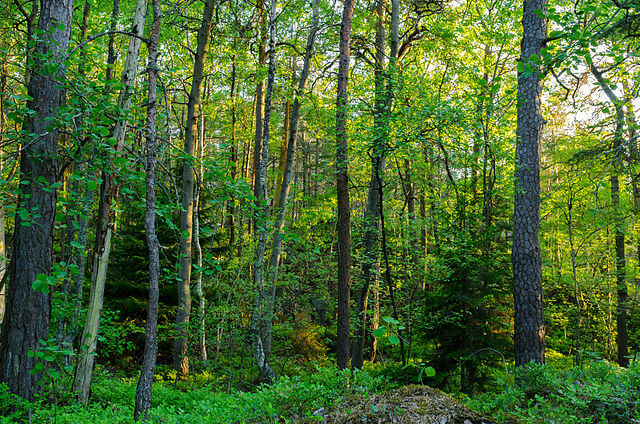
A recent study suggests that forest conservation and restoration could play a significant role in addressing the climate crisis, provided substantial reductions in greenhouse gas emissions are achieved.
The research, published in the journal Nature and conducted by hundreds of leading forest ecologists, indicates that allowing existing trees to mature in healthy ecosystems and restoring degraded areas could sequester 226 gigatonnes of carbon.
This amount is roughly equivalent to nearly 50 years of US emissions for 2022. The scientists emphasise that relying on mass monoculture tree-planting and offsetting won’t unlock the full potential of forests.
Approximately 50% of Earth’s forests have been cleared by humans, with ongoing destruction in vital regions like the Amazon rainforest and the Congo basin. The study estimates that in areas outside of urban agricultural zones with low human footprints, forests could draw down substantial amounts of carbon.
The research suggests that protecting standing forests, allowing them to mature into old growth ecosystems, could realise 61% of the carbon drawdown potential. Examples include the Białowieża forest in Poland and Belarus or California’s sequoia groves. The remaining 39% could be achieved by restoring fragmented forests and previously cleared areas.
Biodiversity is highlighted as crucial for forests to reach their carbon drawdown potential, emphasising the need to avoid mass planting of single species. Urgent cuts to fossil fuel emissions are also deemed necessary.
Concerns about greenwashing in relation to nature’s role in climate crisis mitigation are addressed, with the researchers emphasising the importance of meeting global commitments to halt and reverse deforestation by the end of the decade.
The study acknowledges that rising forest fires and increased temperatures due to the climate crisis could potentially limit the full potential of carbon sequestration.
“Most of the world’s forests are highly degraded. In fact, many people have never been in one of the few old growth forests that remain on Earth,” said Lidong Mo, a lead author of the study. “To restore global biodiversity, ending deforestation must be a top priority.”
World leaders, including those at Cop26 in 2021, pledged to address deforestation by the end of the decade, but current data indicates that progress is insufficient. Brazil, Colombia, and Indonesia are making strides, though, and the researchers stress the importance of meeting global targets to unlock forests’ full potential.
“Conserving forests, ending deforestation and empowering people who live in association with those forests has the power to capture 61% of our potential. That’s huge. It’s potentially reframing forest conservation. It’s no longer avoided emissions, it’s massive carbon drawdown, too,” said Tom Crowther, the head of the Crowther Lab at ETH Zurich. He said thousands of different project and schemes were needed to preserve and revive forests.
“It can be achieved by millions of local communities, Indigenous communities, farmers and foresters who promote biodiversity. It could be agroforestry for cacao, coffee or banana, natural regeneration, rewilding or creating habitat corridors. They’re successful when nature becomes the economic choice. It’s not easy but it’s doable.”
The research follows a controversial 2019 paper on forests’ potential in mitigating the climate crisis, prompting scientific debate and concerns about greenwashing.
Simon Lewis, a professor of Global Change Science at University College London who was a leading critic of the 2019 paper, said the new estimate was much more reasonable and conservative.
“There is a lot of spin and bluster about what trees can do for the environment. To cut through this always ask: what is the amount of carbon taken up by a hectare of land, and over what time period, he said. “The spin on what trees can do for the climate will no doubt continue. But there is still only a finite amount of land to dedicate to forests, and ability of trees to sequester carbon is limited. The reality is that we need to slash fossil fuel emissions, end deforestation, and restore ecosystems to stabilise the climate in line with the Paris agreement.”
Crowther acknowledged that he had been overzealous in the messaging around the 2019 paper.
“When I spoke to the media as an excitable 30-year-old, I said, guys, restoration has this incredible potential. And I was naive to the fact that to non-ecologists, that sounds like you’re saying tree planting has incredible potential,” he said.
“The fact that it was so much carbon I think gave people the idea that [the study] was suggesting that tree planting could be an alternative to cutting emissions, which categorically cannot be.”
——————————————————————————
At Natural World Fund, we are passionate about stopping the decline in our wildlife.
The decline in our wildlife is shocking and frightening. Without much more support, many of the animals we know and love will continue in their decline towards extinction.
When you help to restore a patch of degraded land through rewilding to forests, meadows, or wetlands, you have a massive impact on the biodiversity at a local level. You give animals a home and food that they otherwise would not have had, and it has a positive snowball effect on the food chain.
We are convinced that this is much better for the UK than growing lots of fast-growing coniferous trees, solely to remove carbon, that don’t actually help our animals to thrive.
This is why we stand for restoring nature in the UK through responsible rewilding. For us, it is the right thing to do. Let’s do what’s right for nature!
Donate today at https://naturalworldfund.com/ and join in the solution!

